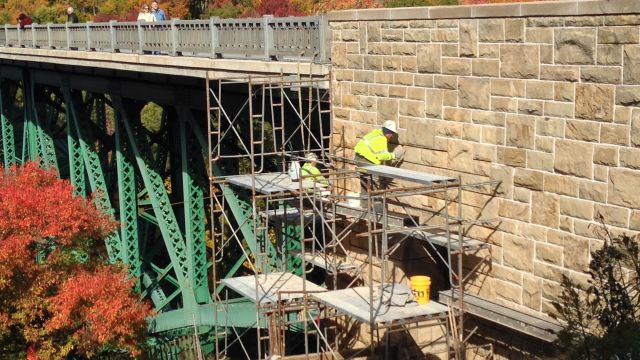Restoring the historic Cut River Bridge
Rehab and restoration case study
By Masonry
After more than 70 years of braving harsh Michigan winters, the stone facade of this iconic Cut River Bridge was ready for a facelift.
Because the restoration had to be reviewed and approved by the Michigan State Historic Preservation Office and comply with federal laws, a mortar material that had similar physical properties to the existing sandstone was required. The scientifically formulated restoration mortar chosen was up to the task.
Located along historic US Route 2 in Michigan’s Upper Peninsula, the steel deck cantilever truss Cut River Bridge was constructed between 1940 and the end of World War II, and is among Michigan’s largest and most well-known historic bridges.
Soaring 147 feet above the Cut River, with spectacular views of Lake Michigan from its deck, the bridge was designed to be a tourist attraction as well as a functional piece of infrastructure. Sidewalks built above the bridge give visitors a bird’s eye view of the bridge, while a set of stairways built into the base takes pedestrians under the bridge. There, they can get a close up view of the supporting trusses.
The abutments and piers constructed to look like stone cut arches feature exceptional detail and decorative stone facing. Extensive lattice and v-lacing on its riveted, built-up members give the bridge a great amount of visual complexity.
It, along with a roadside park and a series of trails around the structure, has been maintained by the Michigan Department of Transportation (MDOT) for more than 70 years, during which time the severe weather extremes of the Upper Peninsula took a toll on the structure’s stone facade.
In 2012, MDOT was awarded an Enhancement Grant for restoration of the existing sandstone fascia and mortared joints on the abutments of the Cut River Bridge (B01-49023) in Mackinac County, Mich.
The scope of work for this $800,000 landmark restoration project included the removal of existing cement mortar material between the sandstone veneer on the panel abutments, and repointing of the joints with a mortar material with similar physical properties to the existing sandstone, as mandated by federal law. MDOT requested that the proposed mortar material also be used to reconstruct existing sandstone damaged from freeze-thaw spalling and weather erosion.
The material used for this work could be modified by the addition of pigments to match the existing color and striation of the sandstone. Since the Cut River Bridge was eligible for – and subsequently included on – the National Register of Historic Places, the work was subject to review and approval by the Michigan State Historic Preservation Office.
The restoration project was let in 2014 using an innovative “Fixed Price Variable Scope” contracting method, based on the available enhancement funding. The sandstone panels were broken down into 33 segments or units, and were prioritized based on surface appearance and visible distress. The bid tab required bidding in sequential order, beginning with the lump sum for Mobilization and a lump sum item for Training, Oversight and Prep Work required for installation of the product. From that point, each of the 33 segments of the sandstone bridge panels would be listed with the highest priority first, followed by each subsequent segment, which would have a dollar amount bid in order of priority.
The winning bid was submitted by Anlaan Corp., with Pneumatic Restoration Inc. doing the repairs. Jahn mortars were used for the patching and pointing. Work began in July of 2014 and is scheduled to be completed in June 2015.
Repair to the bridge was needed to maintain the integrity and strength of the sandstone pillars that have eroded over time, while preserving the historical significance and appearance of the structure. Robert Foguth with Pneumatic Restoration is project foreman and was joined by journeymen installers Keith and James Foguth – all of whom had been trained by Cathedral Stone to be certified Jahn Installers. On-site training and inspections were provided by Cathedral Stone Products President Dennis Rude, who spent three days working with the contractor, the MDOT team as well as Chris Rupinski, construction engineer.
While the structure has been known as the Cut River Bridge since its construction in the mid-20th century, it will be re-dedicated in October 2015 as the “Heath Michael Robinson Memorial Bridge.” The name honors United States Navy Special Force Operations Senior Chief Heath M. Robinson, U.S. Navy SEAL from Alma, Mich., who was killed in action in Afghanistan on Aug. 6, 2011.
Originally published in Masonry magazine.
About the Author
Masonry, the official publication of the Mason Contractors Association of America, covers every aspect of the mason contractor profession - equipment and techniques, building codes and standards, business planning, promoting your business, legal issues and more. Read or subscribe to Masonry magazine at www.masonrymagazine.com.



















